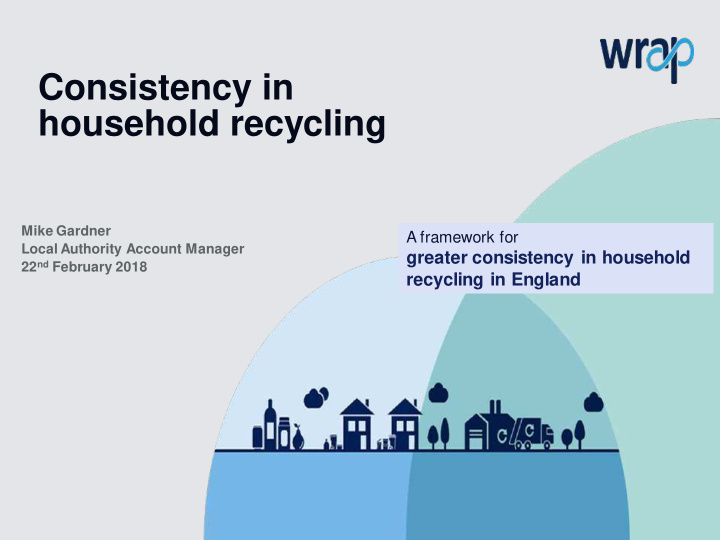



Consistency in household recycling Mike Gardner A framework for Local Authority Account Manager greater consistency in household 22 nd February 2018 recycling in England
Within the Framework – a 5 point action plan: • Packaging: rationalising plastics packaging and removing elements that hinder recycling • Communications: – the role of the whole supply chain, on pack labelling • Collections: Evaluating the case at a local level Collections contracts Bin colour consultation Recycling Guidelines • Infrastructure, reprocessing and markets: Future requirements – with a focus on dry recycling Material Quality and Markets • Policy review
Packaging Priority areas identified Engaging with more brands, retailers, manufacturers to take it forward Key areas: • PVC • Black plastic (in conjunction with Recoup) • Increasing recycled content • Clear labelling
Communications
Infrastructure and reprocessing Recycling Guidelines - published Capacity and capability – ongoing End markets – plastics packaging
Collections • Evaluating the business case for Greater Consistency at a local level • Contract documentation under development
Collections – Dry recycling No. of LAs collecting glass, paper, card, tins/cans, plastic bottles and PTTs (England) 250 220 214 197 200 172 NUMBER OF AUTHORITIES 147 150 111 100 50 0 2008/09 2009/10 2010/11 2011/12 2012/13 2013/14 2014/15 2015/16 2016/17 PERIOD
Collections – food waste England – food and garden Separate food waste collections - England mixed 120 80 109 72 104 68 100 70 100 94 85 60 54 NUMBER OF LAS 80 NUMBER OF LAS 49 50 38 60 40 30 40 20 20 10 0 0 2012/13 2013/14 2014/15 2015/16 2016/17 2012/13 2013/14 2014/15 2015/16 2016/17
Local authority collections work • Evaluating the business case for Greater Consistency at a local level • 24 projects supported covering 84 individual authorities • In the North East: • Durham County Council: • Northumberland County Council • Newcastle City Council • North Tyneside Metropolitan Borough Council • Stockton Borough Council
Evaluating a range of collection options 5 - TS (Co + 1 - Co, FW Sep 2 - Co, FW Pod 3 - KS 4 - TS (C+F) Glass) Fortnightly Co-mingled Weekly Multi- Fortnightly Two- Fortnightly Two- Stream Stream (Container Stream (Comingled Dry Recycling plus Fibre) plus Separate Glass) Weekly Separate Food Waste Fortnightly Charged Garden Fortnightly Residual 1 - Co, FW Sep 2 - Co, FW Pod 3 - KS 4 - TS (C+F) 5 - TS (Co + Glass)
Food waste collections
Impact of separate food waste collections on recycling rates 40,000 55% 35,000 CBC Total Household Waste Collected 30,000 50% 25,000 Recycling Rate (tonnes/year) 20,000 45% 15,000 10,000 40% 5,000 0 35% BL - BL - 1a - Sep 1b - TS 2a - F Co, 2b - F Co, 3 - KS 2015/16 2016/17 FW (C+F) Sep FW FW Pod Residual Waste 17,896 18,901 16,315 16,537 15,857 15,857 16,951 Garden Waste 8,554 9,716 8,554 8,554 8,554 8,554 8,554 Food Waste 450 511 2,032 2,032 2,032 2,032 2,032 Dry Recycling 9,167 8,403 9,167 8,944 9,625 9,625 8,531 NI192 46% 45% 49% 49% 49% 49% 50%
Example 1: Costs modelled with current arrangements for the treatment of organic waste Blue = WCA costs, Grey = WDA costs, Green hatched = ‘Whole system’ costs; None of the modelled options cost less than the baseline
Example 2: Costs modelled with assumed ‘typical gate fees’ for organic waste treatment Blue = WCA costs, Grey = WDA costs, Green hatched = ‘Whole system’ costs All of the modelled options cost less than the baseline
Example 3: costs modelled for Option 1b with assumed ‘typical gate fees’ for organic waste treatment plus the following sensitivities: (i) = increased yield of food waste; (ii) = smaller residual bin but no change in frequency of collection (iii) = 3 weekly residual collections (iv) = chargeable garden waste Options with 3-weekly residual collections and chargeable garden waste show the greatest savings when compared with the baseline.
Local review – summary of findings Cost and performance: Cost Ranking Recycling performance Percentage of results falling least cost highest cost deviation from baseline in each ranking 1 2 3 4 (percentage points) Baseline 52% 16% 16% 16% - System Co-mingled + Food 0% 12% 24% 64% -3.6 to +18.0 Two-stream + Food 20% 36% 32% 12% -2.5 to +18.0 Multi-stream + Food 28% 40% 24% 8% -1.0 to +18.0 NB: negative recycling rates relate to assumptions regarding residual waste capacity
Pilot business case projects – key findings • Business case positive for some authorities under certain circumstances • Key factors impacting on business case • Existing residual waste collection service • Disposal costs • Level of service change required • Where food is already in place, potential cost savings in 80% of cases • Potential to mitigate costs of adding separate food through considering residual waste frequency and garden waste services. • The costs of separate food waste collections can be reduced through the delivery of a shared service.
Thank you for listening
Recommend
More recommend